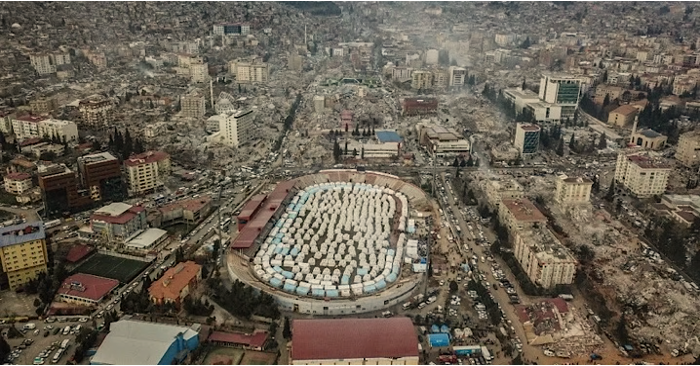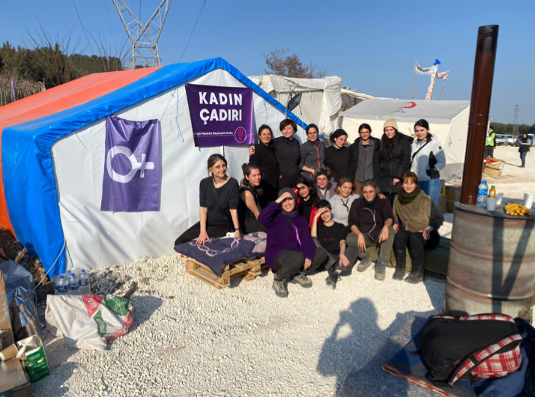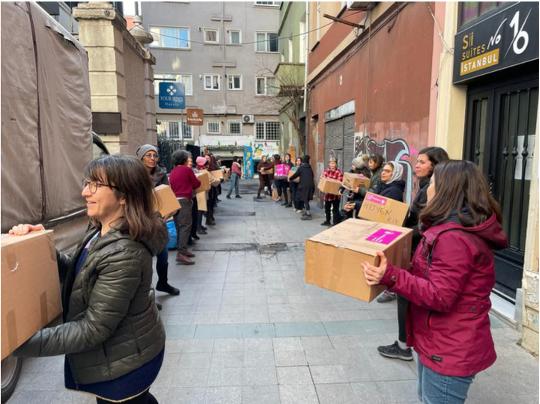[urban interfaces] Blogs
“Queer in the City” Dossier Part 4 – Leaning on each other: queer-feminist approaches to urban catastrophes
This blogpost by Gustavo Rigon is part 4 of a four-part dossier on “Queer in the City”.
Leaning on each other: queer-feminist approaches to urban catastrophes
 Image: City-tent camp at Kahramanmaras stadium, Turkey. 2023. Photo: Reuters[1]
Image: City-tent camp at Kahramanmaras stadium, Turkey. 2023. Photo: Reuters[1]
Syrian people are doubled displaced, they are displaced from their home in Syria and they come to Turkey, and are displaced within this earthquake. I know in some years people will frame this as a climate migration. They have to move, and they are living into tent-cities now, trying to make home there. Feminists really know how to live in that, because living in the context of Turkey, under a patriarchal regime, they know how to create a life and living[2]
Catastrophic events have significant impact on cities infrastructures and the lives of its habitants. Often referred to as “natural disasters”, tornados, earthquakes, and floods disrupt the everyday life of people, which demands the manifestation of collective mutual aid from local as well as international governments and organizations. Undoubtably, such disasters will continue to occur regularly in many parts of the world as a cause of the ongoing global climate catastrophe, even as we assume that we are incapable to prevent them.
However, by exploring the terrain of the Turkey Earthquake in 2023 and its aftermath through the lens of queer and feminist works of solidarity, I came to understand such natural disasters as “urban catastrophes”. As such, instead of seeing them as merely “inevitable” or “acts of God”, natural events are considered an outcome of the unruled mass exploitation of land and natural resources that lead to greater carbon emission and land erosion. As pointed by Rosi Braidotti (2019) the term “biopolitics”[3], refers to how modern states govern populations, emphasizing the regulation of life as well as death. Indeed, although they are considered acts from nature, the disasters we refer to are effects of human activity and further exasperated by economic, ecological, and social policies. Such policies, in addition to profit-maximizing building policies, erode the possibility of effective resistances and responses of not only humans, but also buildings and the land itself, to a catastrophe such as the earthquake in Turkey. The consequences and experiences of such biopolitical work is further intensified within the urban context and demands local analysis of human experience.
In addition, queer and feminist theories have critically considered which subjects come to be classified within the “human” category (e.g. Male, straight, white, able-bodied), as well as how non-human lives also come to be put into risk as a result of human modifications to land in favour of profit-maximizing economic growth. In the middle of a city falling apart and where many are without homes, the uneven distribution of vulnerability across communities and neighbourhoods makes clear and underscores how social differences along race, class and gender are exacerbated during times of crisis. The intertwining of socio-cultural factors with natural sciences and urban politics paints the earthquake as a bio-political urban catastrophe. The “urban”, in urban catastrophes, also includes the ways cities are planned and rebuilt. The question of what it means to think the city in a different way puts at stake the allocation of resources, infrastructure quality, and how role institutions play in shaping the understanding of urban catastrophes as well as its impacts.
In the context of Turkey, the experiences of women and queer individuals seem heavily influenced by heteropatriarchal norms specific to questions of social reproduction as well as domesticity. For instance, through a queer lens of the urban catastrophe, displaced LGBTQ+ Turkish and Syrians may confine their identity to their bedrooms and their close group of friends, but at the same time keeping such identity a secret to their parents and others who belong to the public sphere. In an online interview for Xtra magazine, Hussam, a queer survivor of the earthquake who is not out to their family, states “My queer books and other personal possessions are still at my home. My building was only partially destroyed so I’m nervous that my family will be allowed to return and discover my identity… I don’t know if this will actually happen but there’s still the fear”[4]. The statement by Hussam centres the queer trouble of simultaneously having to worry about finding a new temporary home during a catastrophe while also worrying about returning to the ruins of your old home and risking being outed to their parents’. For queer people, a home is never neutral grounds, which reveals the sedimentation of heteropatriarchy within the question of housing and “the home”. Observing the home within the context of an urban catastrophes through a queer lens, reveals interesting points. Firstly, how returning to buildings that were already in precarious conditions is far more dangerous for some people than others, which in term suggests how the replication of the domesticity to temporary homes is observed to exclude and include certain individuals. Within a chaotic reality, transnational solidarity plays a crucial role.
Here I bring in a few ideas that emerged through my dialogue with a Turkish feminist friend, Jülide Eda Sezer[5]. Both of us, as non-Dutch individuals based in Utrecht (NL), find the question of transnational urban solidarity particularly relevant and interesting, especially considering our own experiences as gendered and queer individuals who have ties to cities who are, and have, faced an urban disaster, and who have had to experience such disasters from a distance. For instance, Sezer denounce the Turkish states management of the crisis and the breach of the social contract expected between the state and a population in need. She found that the unequal ways in which the state relates to especially queer and trans people before the crisis, was carried on over into the management of said crisis. She states: “Trans people couldn’t get access to the hygiene, clothes, healthcare, nothing, nothing. But it is not because they are ontologically trans, but because of state and institutional relationality to them”[6].With the appearance of city-tents as official temporary homes, binary gender and sexual roles enforced within the confines of home and family were carried on over into these new temporary constellations. Wives were automatically confined to domestic labour, household duties, and child-rearing, and children were expected to conform to heterosexual orientations. This pattern is mirrored in the city-tents, as Sezer points out:
They have to take care of child in tents, they have to provide food, they have to cook in tents, they have to make it home; safe feeling area, in a tent, under many conditions, sometimes minus five degrees, maximum ten degrees. So, as mothers, they had to give the care to their fellow women and their children. I am not doing the division of what men were doing because of course they are suffering as well, but the labour, the domestic labour, continued on the tent.[7]
Through observing from an outside perspective one of the city-tents villages in the Turkish Diyarbakır, a question emerges: how does the complication of home as a safe space, and the displacement of an entire city, impact urban planning and the future of cities? According to Jülide, the poor and late response to the catastrophe by the current president Erdogan was tied not only to the at the time upcoming elections, but also reflects the conservative inclination to exploit current urban catastrophe for political gain, rather than ensuring accountability in urban planning and government funds management.
Academics and scientists have already raised concerns about the fragility of the soil and the poor construction of buildings in the affected areas in 2023, given that this is not the region’s first earthquake. The text “On planning and disaster: notes from an earthquake” explains that a catastrophe is not only determined by natural forces but heavily influenced by urban planning. As Burç Köstem (2023) says:
Disasters are instead shaped by a “social calculus” that determines and distributes their every aspect – from the structural causes that lead to the collapse of some buildings and neighbourhoods while leaving others intact, to the level of disaster preparedness in different regions, or the effectiveness of the response and the reconstruction that follows.[8]
The initiation of a new cycle of construction starts, which points out how urban disasters can serve to displace the population strategically. Some areas become more habitable than others, and some are deemed inhabitable, which puts into question how power is distributed in space and why it takes the shape that it takes. However, I argue that reconstruction efforts are based not only on factors of economic growth, but also political interest, which creates a dominant framework that determined how cities are shaped.
After asserting that an urban catastrophe largely results from urban political planning, Köstem elucidates: “One could argue that the grassroots mobilizations that emerge after a disaster is demonstrative of what planning truly means: not only coordinating knowledge but building the capacity to exercise collective power and self-sufficiency”[9]. This statement encourages us to rethink the city otherwise[10] orients me towards Esteban Muñoz statement that queerness is not yet here, which promises a city that is about to come and that must necessarily orient our political desires towards so as to find ways of existing in the present toxic city. Catastrophes of this kind highlights the centrality of housing and the organization of collective aid, and its interaction with positions of gender, sexuality, race and class, which became central to how we think through our relationality with the city. Also, it questions how we can visualize urban planning beyond the limited landscape of the here and now.

Image: Women’s tent during the day. 2023. Photo: Aslı Zengin

Image: Preparations for the Purple Truck. 2023. Photo: Aslı Zengin
In the aftermath of the earthquake, the city-tent offered an opportunity to observe the complication of structural gender and sexuality roles and how solidarity came to be a powerful feminist tool of survival and imagining otherwise. Following the idea of a city otherwise, we turn to a more intimate context: the “inside” of a city-tent camp. By examining the organization of feminist movements and mobilizations, the article “Why do we need feminist responses to disasters?”[11] exemplifies international feminist solidarity, which emerged as a grassroots response network, distinct from aid coordinated by Erdogan and his representatives. Feminists strategically seek aid that recognizes the unique needs of themselves and their communities, emerging from specific locations of experience and knowledge.
In the precarity of the tents, the flow of solidarity is crucial. Beyond survival needs, solidarity connects humans with non-humans, subjectivity with body action, the “inside” with the “outside”, and unite feminist women and queer activists in a political positionality against state surveillance and control over the city, as well as tents borders and flow of supplies. Women and queer individuals manifest and make claims for safe spaces where specific biological, social, and cultural needs can be acknowledged and met. In the Turkish context, what emerged were feminists organized transnational support groups that deviated from the way mainstream solidarity is performed and how support was circulated by the state. For example, the Women’s tent and Purple Truck cases[12] reveals transnational network of community and mutual support beyond the normative that centred unique material and political needs in times of crisis.
As such, solidarity in the context of material (and political) catastrophe emerges as a force that entangles the ways we relate with the urban. How the displacement of the home challenges our understanding of solidarity, and how feminist thinking can help in the ways we manage urban catastrophes aftermaths. In our dialogue, a cultural difference caught my attention. When observing the etymology of Solidarity[13] in English, which comes from Latin and means “whole” and “unity”, a western view on solidary may be understood as an exchange of values. Beautifully put, Sezer instead translates the concept of solidarity from English to the Turkish context:
In my language, solidarity (dayanisma) does not come from a Latin word, it comes from ‘dayanmak.’ To lean against. You’re there for one another. And the word itself has that mutuality. Dayanışma. It’s not like I am leaning against and you are supposed to hold me. My body’s leaning against your body is a mutual pressure. We are holding each other, leaning against each other. So, the verb itself is already showing the mutual care.[14]
Arriving to another perspective about solidarity may be a starting point on rethinking the sociality of the home, which eradiates through individuals, communities and more broadly, the city. By looking at feminist examples of solidarity, we understand ways of performing collective survival, and question how urban systems must rethink the ways we build spaces and live together. Our dialogue shows that feminist and queer solidary is crucial for urban catastrophes and that urban catastrophes reveal already sedimented inequal political, cultural and urban policies and norms. This approach is not blind regarding categories of gender, race, and religion. Instead, it considers these categories as locatable knowledges emerging within social, political, and geographical contexts. Although the demand for political justice in the context of climate catastrophes has been a widely global concern, specific local material formulations and discourses matter in a context where the primary goal is survival and safety.
The practice of mutual aid and care in a large scale may become more frequent with climate changes. Such mutual aid and care highlights questions of social participation, cooperation, biases, grassroots and mainstream solidarity movements etc, and how such questions leads us to reconsider forms of actions and responses regarding the critical transformations that cities are facing. Transformations that are the result of biopolitical management of space and human activity. On a more personal note, I observe that queer and feminist approaches to solidarity views vulnerability as a powerful social bond that moves cross borders. It finds alternative ways to attend to specific groups and their needs and tries to not act according to biased dominant orders. Sezer points out how language and cultural differences affect the ways we move in space in order to practice solidarity. When saying dayanisma, one is not “giving solidarity or showing solidarity”, but “doing it, like mutually. Embodied practice”[15]. Language and culture play a crucial role in critically forming the ways we understand social roles in the urban and rethinking these conceptual formulations may shed light in facilitating transnational practice of mutual aid.
To conclude, the exploration of the aftermath of the Turkey earthquake through a queer and feminist lens shows urban catastrophes is a concept that shows these events as products of the relation between human interventions, societal structures, and political decisions. By delving into the experiences of women and queer individuals, this essay sheds light on the reinforcement of heteropatriarchal norms during crises which in turn impacts concepts of home, identity, and safe spaces. The feminist critique extends to governmental responses, emphasizing the urgency of accountability in urban planning and resource allocation. Through the lens of feminist solidarity, the transformative potential of collective care and mutual support becomes evident, challenging classic notions of solidarity. The city-tents emerge as dynamic platforms for feminist solidarity, challenging heteronormative norms and creating spaces for specific groups. A queer approach to solidarity calls for a re-evaluation of urban planning, advocating for collective power and self-sufficiency as indispensable elements in shaping cities otherwise.
Works Cited
Braidotti, Rosi. 2021. Posthuman Feminism. London : Polity Press.
Freedom, Stockolm Center for. 2023. Tent city in earthquake disaster zone at risk of flooding, warns Turkish Chamber of Civil Engineers. Accessed April 2023. https://stockholmcf.org/tent-city-in-earthquake-disaster-zone-at-risk-of-flooding-warns-turkish-chamber-of-civil-engineers/.
Kesler, Jacob. 2023. Xtra Magazine. https://xtramagazine.com/power/relief-lgbtq-turkey-syria-earthquake-fundraiser-246391.
Köstem, Burç. 2023. “On planning and disaster: Notes from an earthquake.” Uneven Earth – Where the ecological meets the political.
Oswin, Natalie. n.d. “For the city ‘Not yet Here’.” Queering Urban Studies – International Journal Of Urban and Regional Research.
Sezer, Jülide Eda, interview by Gustavo Rigon. 2023. Dialogue with Jülide Eda Sezer (May).
Zengin, Aslı. 2023. “Why Do We Need Feminist Responses to Disasters?”
notes
[1] Image of a city-tent camp. https://en.vijesti.me/world/globus/643350/disaster-from-the-air-in-turkey-and-syria-after-the-earthquake-filmed-by-a-drone (2023)
[2] In dialogue with Julide Eza Sezer (2023)
[3] Rosi Braidotti borrows from Foucault in Posthuman knowledge (2019)
[4] Jacob Kessler, “LGBTQ+ Syrians face discrimination after surviving earthquake”, https://xtramagazine.com/power/relief-lgbtq-turkey-syria-earthquake-fundraiser-246391 (2023).
[5] At the time, Jülide Sezer worked with earthquake donations through ATGENDER (European Association for Gender Research), based in Utrecht.
[6] In dialogue with Jülide Sezer (2023).
[7] Ibid
[8] Köstem “On planning and disaster: notes from an earthquake” (2023).
[9] Ibid, 9.
[10] Natalie Oswin “The city ‘not yet’ here” (2019).
[11] Aslı Zengin “Why do we need feminist responses to disasters?” (2023)
[12] Ibid
[13] Online Etymology Dictionary (2023).
[14] In dialogue with Jülide Sezer (2023).
[15] Ibid

